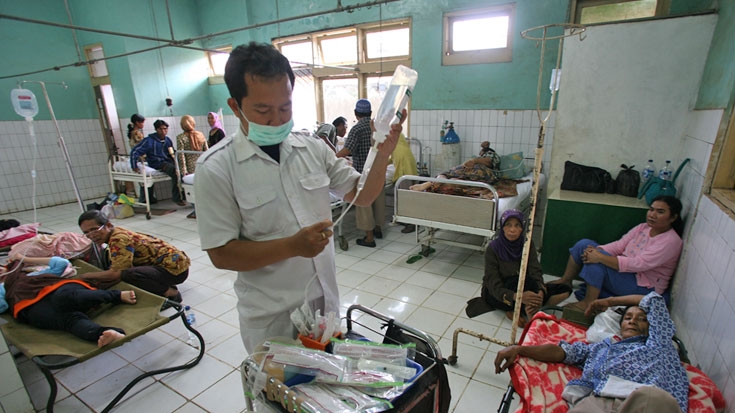Health outcomes have significantly improved in Indonesia since the 1960s. The child mortality rate has declined from 220 per 1,000 live births in 1960 to 45 per 1,000 live births in 2007. Preliminary results from the 2007 Indonesian Demographic Health Survey (IDHS) show a significant decrease in the Maternal Mortality Ratio (MMR). Likewise, nutrition status has shown steady progress from 38 percent in 1990 to 25 percent in 2000. These factors have contributed to improvement in life expectancy from 43 in the 70’s to 70.5 in 2008. In spite of the above progress, improvement in the Infant Mortality rate (IMR), has slowed down, even stagnated in the last five years. The national average masks serious geographic differences in progress including substantial variations in IMR between provinces and malnutrition rates. These discrepancies are also shown in coverage of health programs such as antenatal visits, skilled birth attendance, and complete infant immunization rates.
At the same time, Indonesia faces demographic challenges, numerous epidemics, and it is at a nutrition crossroads. Communicable diseases remain a significant challenge to the health system as demonstrated by increasing trends of various neglected communicable diseases such as filariasis. Tuberculosis case detection varied widely across regions. Growth of the HIV/AIDS epidemic among high-risk groups is alarming, although it remains concentrated, with low prevalence rates among the general population. Non-communicable diseases including cardiovascular diseases, metabolic disease, and cancers, have also been detected to increase and become major causes of death.
Significant investments by the Government and the international community which emphasized systemic hardware has increased access to healthcare but poor quality and inefficiencies remain major concerns. Weak health performance indicates that inefficiencies remain in the health system. The health service provision relies heavily on the public sector, and although the private sector has a significant role in service delivery, the oversight of the private sector is weak. Access to quality services are often hampered by the lack of qualified health workers especially for the poor and those in remote areas.
Decentralization poses both challenges and opportunities to the health sector. On the one hand, the division of roles and responsibilities of different levels of government needs to be clarified, for instance in health personnel management. On the other hand, public health spending and the share of public spending at the sub-national levels following decentralization has significantly increased, out of pocket spending and allocative efficiency in public budget remain important issues in the health financing system. The share out-of-pocket spending for health is still significant which means that risks to fall into poverty from catastrophic health events persist. The coverage of health insurance for the poor, previously known as Askeskin, now Jamkesmas, has been expanded to cover more than 30% of the population, and is projected to cover the entire population. Such decisions require thorough evaluation of the existing schemes, including analysis and assessment of available options which also takes into account other institutional and fiscal capacities.
The government’s Ministry of Health strategy is built on four pillars: community empowerment; health financing; access to health services; and, surveillance. These pillars are translated into programs to achieve the goals as follows: community empowerment would be achieved through the Desa Siaga program, which foresees a health worker (midwife and or nurse) in every village by 2009.
Key Issues in the decentralized setting for health sector in Indonesia:
- Increase allocation for health and at the same time improve allocative efficiency.
- Prioritize in maternal and child (or reproductive) health.
- Ensuring the availability of reliable information to support decision making process, e.g, NHA, unit cots, demand information for development of the health insurance scheme.
